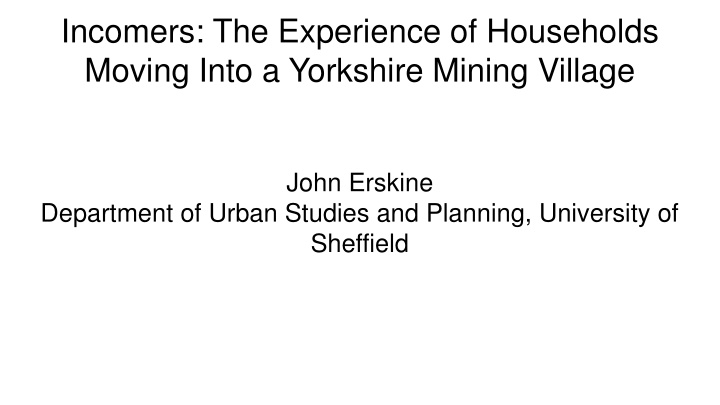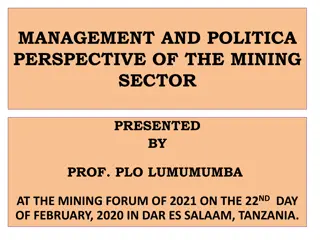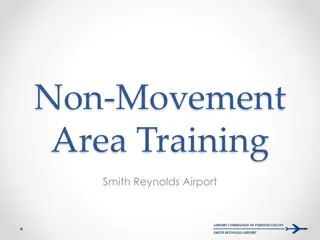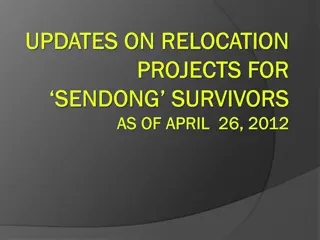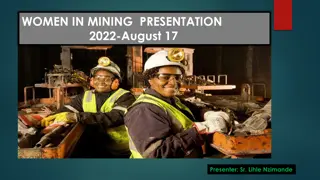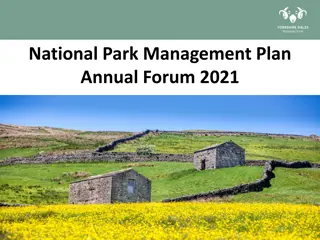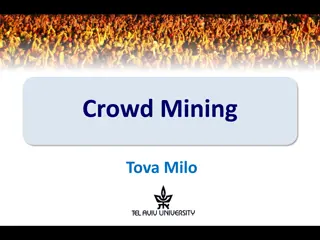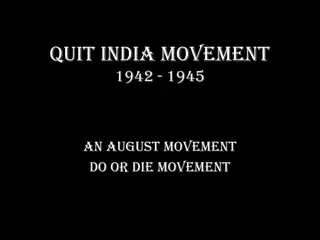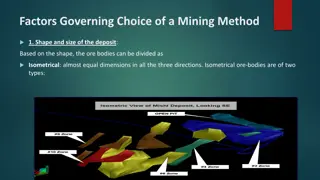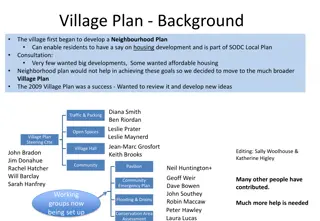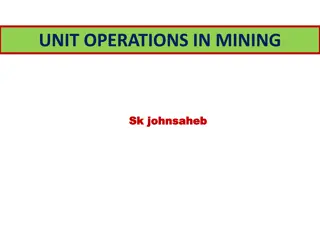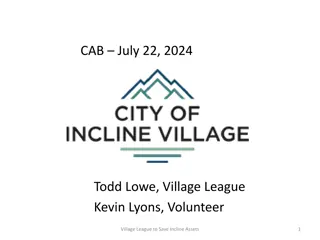Household Movement in a Yorkshire Mining Village
This study delves into the experiences of households relocating to a Yorkshire mining village, exploring their work strategies, challenges, and impact on the local community. Through qualitative analysis, it uncovers the dynamics of household economies and labor allocation in a unique setting. The study provides insights into the village of Ballyhenry, shedding light on the socio-economic fabric and household compositions of the residents. Follow the journey of families like Abigail and Thomas as they navigate difficult commutes and life changes in a rural environment.
Download Presentation

Please find below an Image/Link to download the presentation.
The content on the website is provided AS IS for your information and personal use only. It may not be sold, licensed, or shared on other websites without obtaining consent from the author.If you encounter any issues during the download, it is possible that the publisher has removed the file from their server.
You are allowed to download the files provided on this website for personal or commercial use, subject to the condition that they are used lawfully. All files are the property of their respective owners.
The content on the website is provided AS IS for your information and personal use only. It may not be sold, licensed, or shared on other websites without obtaining consent from the author.
E N D
Presentation Transcript
Incomers: The Experience of Households Moving Into a Yorkshire Mining Village John Erskine Department of Urban Studies and Planning, University of Sheffield
Background Policy Coal Task Force/National Coalfields Programme: 1996-2010... ERDF and ESF Housing Market Renewal: 2002-2011 Personal Professional Experience PhD Research
The Study A qualitative examination of household work strategies and the informal economy in a mining village in Yorkshire Based on approaches developed by Pahl and Williams Initially premised on a hidden economy that did not actually exist for the households studied
Household Work Strategies '...how households allocate their collective effort to getting all the work done that they define has, or they feel needs to be done...' (Pahl, 1984: 113)
The Village: Ballyhenry In the Wakefield Metropolitan District A growing resident population of just over 6000 (2011 Census), with rising economic activity levels Above national and district average in Social Classes C2, D, E Significantly lower qualification levels, with almost 40% with no qualifications Rural location, with post-2000 housing development
The Households 17 households 5 working couples with children 2 working single men, one with a child 3 working single women 2 unemployed/long-term sick 2 retired couples 2 retired single women 12 households with at least one member educated to Level 4 or higher, 5 with postgraduate qualifications All had moved into the village from elsewhere
Abigail (40) and Thomas (42) Difficult commutes to Leeds and Sheffield The impact of long hours A third child born on Christmas Eve A change to working from home No family support
Katie (43) and Mark (42) No typical weeks The demands of a new business Hyper-managed diaries Conscious local networking No family support
Gillian (41) and Terry (48) Three autistic sons Household repairs Negotiating school Pets as a safety valve No family support
Rosemary (46) Choosing to work nights Ten pets Interactions with other pet owners Limited family contact A sub-optimal location
Carole (53) Non-driver, dependent on local cleaning and administrative jobs Living with second husband, Alan Seven grown-up children living within 20km Caring for mother and grandchildren
Conclusions The positive and negative impacts of space and location The importance of care and caring Families (and their absence) matter The importance and the limitations of networks The positive and negative effects of economic change The importance of pets
Link to Thesis https://etheses.whiterose.ac.uk/28808/
Selected References: 1 Bagnall, G., Longhurst, B., & Savage, M. (2003). Children, Belonging and Social Capital: The PTA and Middle Class Narratives of Social Involvement in the North-West of England. Sociological Research Online, 8(4), 128 143. https://doi.org/10.5153/sro.862 Bernstein, B. B. (1971). Class, codes and control. London : Routledge and Kegan Paul, 1971. Champion, T. (2009). Urban Rural Differences in Commuting in England: A Challenge to the Rural Sustainability Agenda? Planning Practice and Research, 24(2), 161 183. https://doi.org/10.1080/02697450902827329 Cheshire, P. (2009). Urban Containment , Housing Affordability and Price Stability - Irreconcilable Goals (Issue September). Cole, I. (2015). The Housing Market Renewal Pathfinder Programme - A Drop of Keynes in a Neo-Liberal Ocean? Built Environment, 41(2), 289 304. https://doi.org/10.2148/benv.41.2.289 De Ruijter, E., Van Der Lippe, T., & Raub, W. (2003). Trust Problems in Household Outsourcing. Rationality and Society, 15(4), 473 507. Dennis, N., Henriques, F., & Slaughter, C. (1969). Coal is our life : an analysis of a Yorkshire mining community (2nd ed.). London: Tavistock. http://copac.ac.uk/search?isn=0422732508&rn=1#.UXkwE0Q-x28.mendeley Elias, N., & Scotson, J. L. (1994). The Established and the Outsiders. Sage Publications. Evans, M., Syrett, S., & Williams, C. (2006). Informal Economic Activities and Deprived Neighbourhoods. Department for Communities and Local Government. http://eprints.mdx.ac.uk/3760/1/Informal_economic_activities_and_deprived_neighbourhoods.pdf Fletcher, D. R. (2009). Social Tenants, Attachment to Place and Work in the Post-industrial Labour Market: Underlining the Limits of Housing-based Explanations of Labour Immobility? Housing Studies, 24(6), 775 791. https://doi.org/10.1080/02673030903205895 Glucksmann, M. (2009). Formations, Connections and Divisions of Labour. Sociology, 43(5), 878 895. https://doi.org/10.1177/0038038509340727 Green, A. E. (2004). Is Relocation Redundant? Observations on the Changing Nature and Impacts of Employment-related Geographical Mobility in the UK. Regional Studies, 38(August), 629 641. https://doi.org/10.1080/0034340042000240941 Hickman, P., Walshaw, A., Ferrari, E., Gore, T., & Wilson, I. (2011). The Houses all Look Posh Now - Evaluating the Impact of a Housing Improvement Programme: The Case of Portobello and Belle Vue (Issue February). Hochschild, A. (2015). Emotional life on the market frontier. Working in America: Continuity, Conflict, and Change in a New Economic Era, 37(1), 89 100. https://doi.org/10.4324/9781315631011 Hochschild, A. R. (2012). The managed heart : commercialization of human feeling. University of California Press.
Selected References: 2 Jarvis, H. (2005). Work/Life City Limits. Palgrave Macmillan. http://www.palgraveconnect.com/pc/doifinder/10.1057/9780230503304 Leather, P., Nevin, B., Cole, I., & Eadson, W. (2012). The Housing Market Renewal Programme in England: development, impact and legacy. Sheffield: CRESR Sheffield Hallam University, January. McDowell, L., Ray, K., Perrons, D., Fagan, C., & Ward, K. (2005). Women s paid work and moral economies of care. Social & Cultural Geography, 6(2), 219 235. https://doi.org/10.1080/14649360500074642 McKie, L., Gregory, S., & Bowlby, S. (2002). Shadow Times: The Temporal and Spatial Frameworks and Experiences of Caring and Working. Sociology, 36(4), 897 924. https://doi.org/10.1177/003803850203600406 McNicholas, J., Gilbey, A., Rennie, A., Ahmedzai, S., Dono, J.-A., & Ormerod, E. (2005). Pet ownership and human health: a brief review of evidence and issues. BMJ, 331(7527). http://www.bmj.com/content/bmj/331/7527/1252.full.pdf Mulder, C. H., & Kalmijn, M. (2005). The geography of family networks. IUSSP XXV International Population Conference Tours, France, July 18-23, 2005, 1995, 1 19. Pahl, R. E. (1984). Divisions of labour. B. Blackwell. Raw, A., & McKie, L. (2020). Exploring Women s Mutuality in Confronting Care-Precarity: Care Accounts a Conceptual Tool. Sociology, 54(1), 53 69. https://doi.org/10.1177/0038038519856236 Rijken, M., & Van Beek, S. (2016). About Cats and Dogs ... Reconsidering the Relationship Between Pet Ownership and Health Related Outcomes in Community-Dwelling Elderly Author ( s ): Mieke Rijken and Sandra van Beek Published by: Springer Stable URL: http://www.jstor.org/stable/41476490. Social Indicators Research, 102(3), 373 388. http://www.jstor.org/stable/41476490 Rowan, C. F. (2015). Health, well-being, and social dynamics in mixed communities. University of Glasgow. Savage, M., Bagnall, G., & Longhurst, B. (2001). Ordinary, Ambivalent and Defensive: Class Identities in the Northwest of England. Sociology, 35(4), 875 892. https://doi.org/10.1177/0038038501035004005 Sihto, T. (2019). Placing women? How locality shapes women s opportunities for reconciling work and care. University of Jyv skyl . Swann, R., & Hughes, G. (2016). Exploring micro-sociality through the lens of established-outsider figurational dynamics in a South Wales community. Sociological Review, 64(4), 681 698. https://doi.org/10.1111/1467-954X.12428 Wallace, C. (2002). Household Strategies: Their Conceptual Relevance and Analytical Scope in Social Research. Sociology, 36(2), 275 292. https://doi.org/10.1177/0038038502036002003 Warwick, D., & Littlejohn, G. (1992). Coal, capital, and culture : a sociological analysis of mining communities in West Yorkshire. Routledge. Watt, P. (2009). Living in an oasis: Middle-class disaffiliation and selective belonging in an english suburb. Environment and Planning A, 41(12), 2874 2892. https://doi.org/10.1068/a41120 Wheelock, J., & Jones, K. (2002). Grandparents Are the Next Best Thing : Informal Childcare for Working Parents in Urban Britain. Journal of Social Policy, 31(03), 441 463. https://doi.org/10.1017/S0047279402006657
